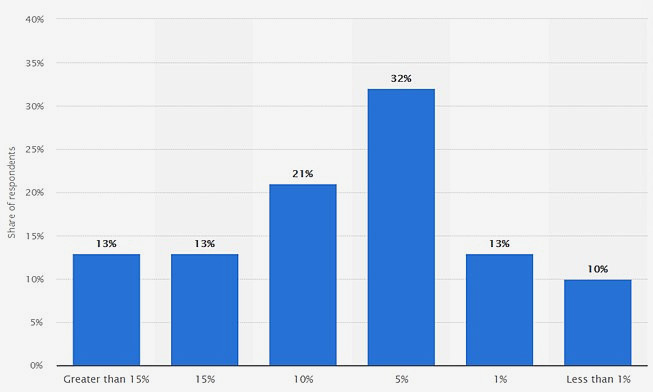A good marketing strategy can help B2B companies grow their digital sales, but the sad truth is that B2B marketing has yet to plan effectively to achieve its potential.
Only 13% of B2B companies spend more than 15% of their budget on marketing. Considering the immense benefit that consistent marketing has on brand awareness and attracting customers, that doesn't make sense.

To understand why B2B marketing is not reaching its full potential, let's discuss common obstacles it faces in today's digital landscape.
Marketing Challenges Plaguing B2B Companies
We can pinpoint four specific challenges that face B2B companies today:
- Involvement in longer, pivotal sales cycles
- Disconnection between Sales and Marketing
- Overreliance on traditional marketing tactics (events, in-person, tradeshows)
- Slow to jump onto streamlined, targeted content marketing tactics
Let's dig into how those challenges affect B2B marketing.
Longer Sales Cycles
B2B buyers are a highly critical asset compared with retail consumers. First, businesses take more logistical steps in making a buying decision than a consumer does for consumer products. Second, more decision-makers are involved.
As a result, the B2B process requires more high-quality, in-depth interactions to convey the product's value and address any concerns. Moreover, the eventual sale will be large, with custom pricing to boot.
B2B organizations take pride in valuing long-term customer relationships, but sales cycles are often slow. Many businesses tend to hyperfocus on nurturing customers and neglect finding new ones.
Sales-Marketing Disconnect
Many B2B companies have plenty of Marketing-qualified leads (MQLs), but the numbers dwindle when converting them to Sales-qualified leads. Only 13% of MQLs are eligible to fit the company's target buyer, according to research by Salesforce. Clearly, Sales and Marketing teams need to align on marketing campaigns.
Reliance on Traditional Outreach
Because they are accustomed to the conventional marketing of the B2B sector, many companies find the transition to e-commerce rocky. COVID-19 steamrolled many B2B companies into digital marketing, but many still rely on in-person events, tradeshows, and expos.
Lack of Streamlined Content Marketing
Along with dependence on offline marketing, many marketers don't have the tools needed to publish consistent content across digital channels.
Organizing a company's B2B digital presence into a well-oiled machine can be a daunting hurdle to overcome. If done manually, the process can take years. However, if marketers neglect e-commerce opportunities, they'll be making the costly mistake of targeting a narrow set of potential leads.
How PIM Helps Set the Tone for Digital B2B Marketing
So how do we combat those B2B marketing challenges?
All digital marketing starts with a website. B2B companies must funnel their focus into a high-quality online presence via their site. It's where you precisely tailor your brand and product content for the desired effect.
One way to oversee product content on all store, marketplace, and retail channels is by centralizing via a product information management system, or PIM. Using PIM, you boost B2B marketing performance by organizing critical product data and marketing assets.
PIM acts simultaneously as a data reservoir and content management tool. Here are six ways that PIM software enables you to polish your B2B marketing strategy.
1. Upgrade SEO
Organic traffic is the first step for increasing Marketing-qualified leads. However, it requires highly targeted, specific keywords scattered across your B2B site.
With a PIM, you can comprehensively embed keywords within product content. Authoring product copy straight on the PIM and integrating keywords from the start helps you hit the ground running.
Visual content is also a plentiful opportunity for SEO. Directly optimize your digital asset metadata and tags to garner more traffic.
2. Automate Essential Marketing Tasks
B2B companies can automate a plethora of assignments critical to marketing on PIM. You can, for instance, automate validation of your product information to make sure all subsequent content is accurate.
PIM automatically facilitates data updates across a B2B company's ERP system. In fact, all product information, including digital assets, follows automated version control rules to remain the most up to date in the master database.
3. Import and Export With Multichannel Capability
Multichannel is an important investment for B2B companies, especially those with highly specific, narrow, and multiple buyer personas. PIM helps organizations focus on each channel's persona with separate, tailored product copy and content. It's easier to attach variations of product dimensions according to the channel. It works through API capability, which helps rush large catalogs to market.
Getting product pages ready for various channels is important for putting products in front of the highest number of potential leads, ASAP. At the same time, PIM makes it possible to maintain a unified marketing message across multiple channels for a maintained brand image.
4. Bulk-Edit Data and Grade Content
Many companies struggle to keep up with the number of product items. Naturally, that makes managing product data for marketing an involved procedure. PIM cuts down on time and costs by organizing all SKUs in one place and empowering organizations to edit product attributes in bulk.
The content grading function also triple-checks that both required and recommended content is complete. Every time you publish product content, rest assured that dimensions, specifications, and other bits of important information are ready to go.
5. Tap Into Crucial Digital Assets for B2B
Managing and publishing only the most engaging product photography is crucial for businesses to showcase all product details effectively. In-use photography, in particular, has a huge influence on buyer interest.
Using a rich variety of assets overall increases engagement, which improves SEO. A PIM that includes digital asset management centralizes all your images, videos, spec sheets, and other assets into one place, ensuring they are all up to date.
Moreover, a PIM automatically resizes images according to channel specifications. Product pages are furnished with the highest quality, most accurate photos, and marketing teams are also better able to coordinate campaigns with consistent product image usage.
6. Have a Brand Portal for Sales and Marketing Teams
An on-platform portal open to all company users gets your marketing and sales team on the same page. Although each team has its own software and workflow—PIM integrates with a CRM as well—both have access to consistently updated product attributes, copy, and product launch details. A PIM reduces data silos between departments for better team synchronization.
It's Time to Support Your B2B Marketing With PIM
Using marketing techniques without a steady product data and content management process might work. However, you cannot guarantee an error-free, efficient process. It's like constructing a building without a sturdy architectural foundation.
PIM adoption leads to cleaner data that is channel-ready for B2B retail partnerships. It allows you to discard the lengthy process of preparing information and materials for Marketing; instead, it's completed seamlessly. Using PIM, B2B organizations can evade the headache of manually organizing content and risking delays, thus considerably enhancing the digital experience.
More Resources on Product Information Management
Why Marketers Should Build Consumer Trust Through Product Data
The Challenges That Product Experience Management (PXM) Can Solve




